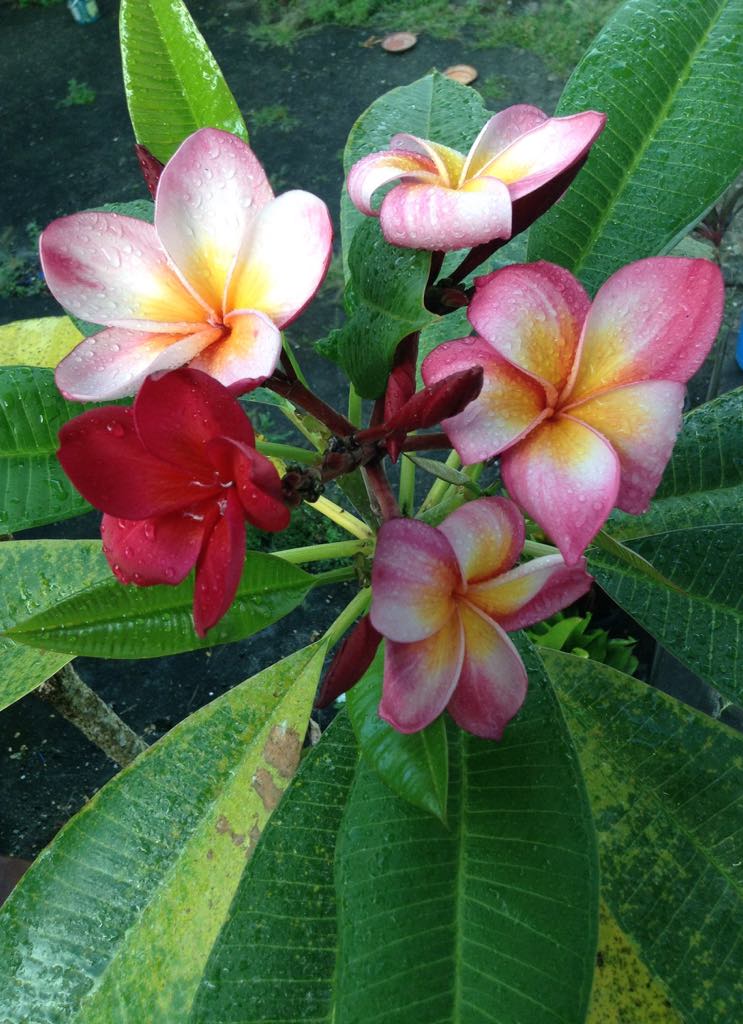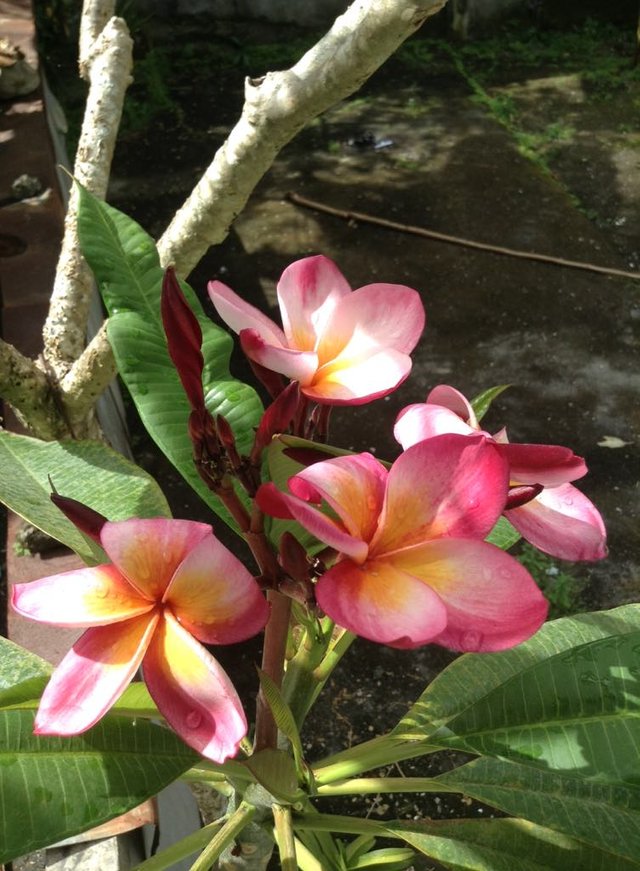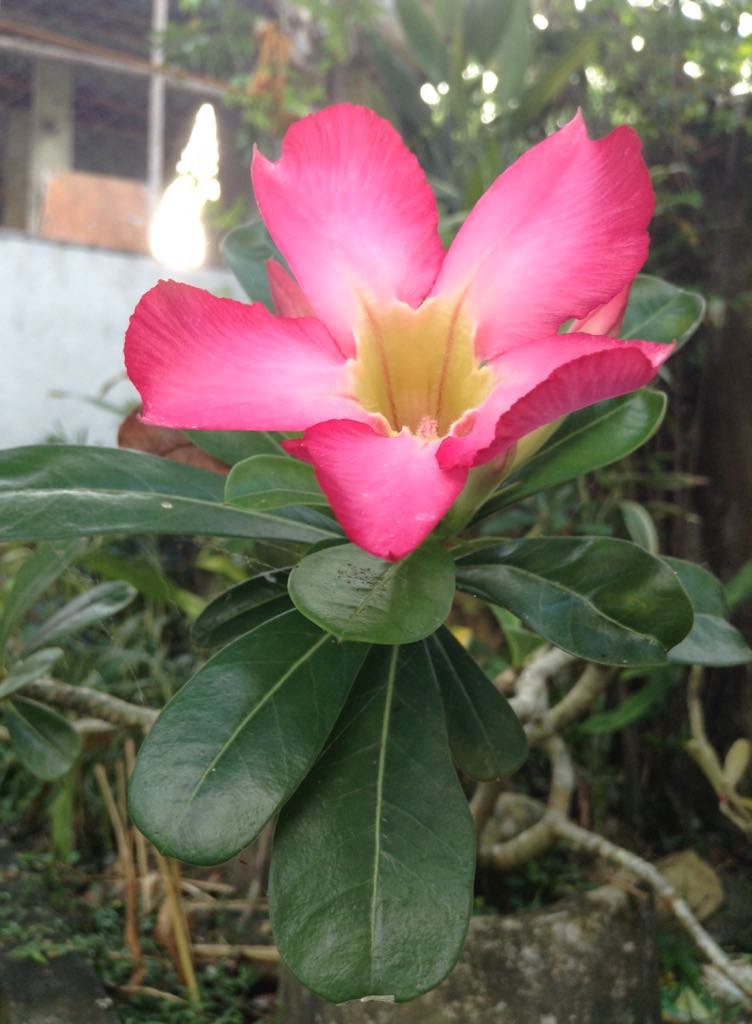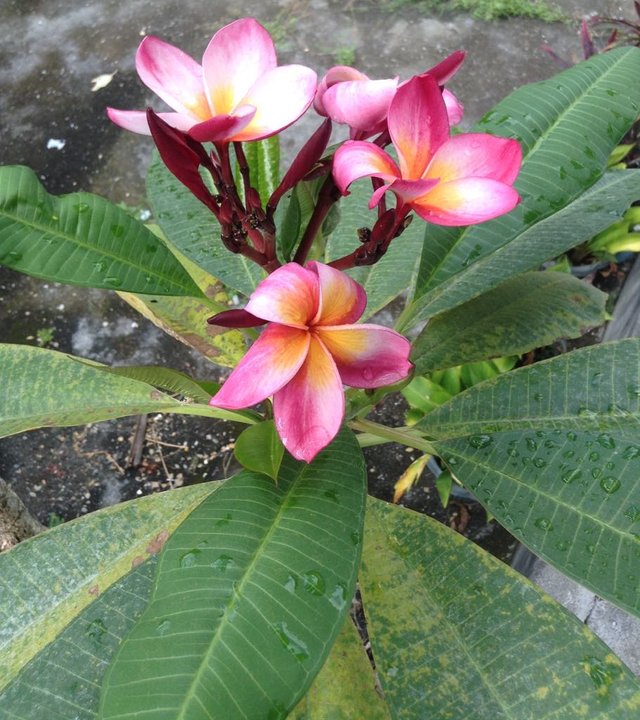Kalachuchi Flower : Frangipani
.jpg)
Hello steemians, today I captured a flower called Kalachuchi.
Do you know the Plumeria rubra (kalachuchi) is not just an ordinary flower? As I read several article about it, I've learned that it can also be used as herbal medicine. I want to share with you the things I’ve learned about the Plumeria rubra (kalachuchi).Kalachuchi is also known as Plumeria rubra (scientific name) It has common name Frangipani or temple flower. In the Philippines Plumeria, which is known in Tagalog as Kalachuchi or Kalatsutsi. The kalachuchi trees are quite popular here in Philippines. It is mainly grown in the Philippines as an ornamental plant. In this post the colored of kalachuchi is red. Kalachuchi is a small, growing up to 5 meters high, with a crooked trunk, smooth and shining stems, succulent, with abundant sticky, milky latex. Bark has a smooth, papery outer layer which is grey, shining, and constantly exfoliating in small flakes. Wood is yellowish-white and soft. Branches are thick, fleshy, swollen and leafy at the tips. The kalachuchi flower comes in many colors: red, pink, orange and white are its main attraction. Flowers are waxy, funnel-shaped, 5-lobed, white, or with splashes of red color. The beautiful petals produce a fragrant smell that can usually fill an entire room or garden.

There are several species of cultivated Plumiera, very similar to P. rubra but for the color of the corolla
Distribution
- Usually cultivated for ornamental purposes.
- Nowhere established.
- Introduced from Mexico by the Spaniards.
- Now pantropic.
Parts utilized
Bark, leaves and flowers.
Constituents
- Flowers supposed to be source of perfume known as "Frangipiani."
- Bark contains a bitter glycoside, plumierid (2%).
- Latex contains resins, caoutchouc and calcium salts of plumieric acid: cerotinic acid and lupeol.
- Leaves contain a volatile oil.
- Phytochemical screening of methanol extract yielded steroids, flavanoids, tannins, alkaloids, and glycosides.
- Powdered leaf yielded alkaloids, cyanogenic glycosides, phenolic compounds, flavonoids, terpenoids, tannins,
and saponins.
Properties
- Sweet tasting and neither warming nor cooling in effect, aromatic.
- Seeds considered hemostatic.
- Considered anti-inflammatory, antipyretic, diuretic, emmenagogue, febrifuge, purgative, rubefacient.

Uses
Folkloric
• Decoction of bark is used as purgative, and febrifuge. Latex is similarly employed.
• Preventive for heat stroke: the material may be taken as a cooling tea.
• Root-bark taken internally as a strong purgative.
• Root bark used as remedy for gonorrhea and venereal sores.
• Bark decoction used as antiherpetic.
• Used in treatment of ulcers, herpes, scabies.
• Bruised bark use as plaster over hard tumors.
• In India, bark used as purgative. Bark also used as application for abscesses.
• In Java and Madera, bark decoction used for gonorrhea, dropsy, and dysuria due to venereal disease.
• In Yucatan, latex is used for toothache.
• In Persia, bark is employed against blenorrhagia.
• For dysentery, diarrhea during summer season: use 12 to 24 gms of dried material in decoction.
• Arthritis, rheumatism, pruritic skin lesions: Mix the latex (sap) with coconut oil, warm, and apply to affected area.
• Decoction of the bark is used as a counterirritant on the gums for toothache.
• The latex mixed with coconut oil is used for itching.
• The juice is rubefacient in rheumatic pains, and with camphor, is also used for itching.
• A poultice of heated leaves is beneficial for swellings.
• Decoction of leaves for cracks and eruptions of the soles of the feet.
• Infusion or extract from leaves is used for asthma. Leaves also used as cigarettes to inhale in asthma.
• In Puerto Rico, in emulsion, the milk produces abundant, bilious, watery stools.
• In Mexico, decoction of flowers used in diabetes.

Studies
• Cytotoxic / Antitumor: In Indonesia, six cytotoxic constituents were isolated from the bark of P rubra. The substances demonstrated cytotoxic activity with panel of murine lymphocytic leukemia cell lines and a number of human cancer cell-types (breast, colon, fibrosarcoma, lung, melanoma, KB). (1)
• Cytotoxic / Antibacterial / Molluscicidal: From the heartwood, study yielded plumericin and isoplumericin which molluscicidal, cytotoxic and antibacterial activity.
• Antibacterial: P rubra was one 41 plants extracts from 18 species that showed antibacterial activity. (3)
• Essential Oils : Comparative study of the essential oils of genus Plumiera Linn. from Malaysia showed the oil of P. acuminata (white flower) was predominantly of benzyl salicylate, benzyl benzoate, trans-nerolidol, neryl phenylacetate and linanlool. (4)
• Phytochemical / Antimicrobial: Study yielded the presence of tannins, phlobatannins, saponins, flavonoids, steroids, terpenoids, cardiac glycosides and reducing sugar from the crude extract. The antibacterial assay showed the methanol extract to inhibit growth of 14 indicator bacteria. The extract of the flower was more active against B cereus. (5)
• Antioxidant / Hypolipidemic: Study of a flavone glycoside isolated from P rubra produced a significant reduction of serum triglycerides in alloxan-induced hyperglycemic rats. Antioxidant activity was confirmed through in vitro studies. (7)
• Anti-Inflammatory / Leaves: A methanol extract of P. acuminata exhibited significant anti-inflammatory activity on acute and chronic experimental animal models. The effect was comparable to that of indomethacin, a nonsteroidal anti-inflammatory agent. (17)
• Antioxidant / Free Radical Scavenging Activity: A methanol extract showed dose-dependent antioxidant activity using a DPPH radical, superoxide anion radical and hydroxyl radical scavenging assays. (16)
• Antimutagenic: Study of ethanol extract of green leaves yielded 4 isolates; three were elucidated a stigmast-7-enol, lupeol carboxylic acid, and ursolic acid. A1 reduced the number of MPCE induced by mutagen, mitomycin C. (9)
• Antimycotic: Study evaluated the antimycotic activity of four medicinal plant extracts: kalachuchi bark (P. acuminata), atsuete bark (Bixa orellana), akapulko leaves (C. alata), and neem leaves (A. indica) compared to standard clotrimazole treatment of otomycosis. Of the four, only kalachuchi bark extract exhibited antifungal activity against Aspergillus and Aspergillus niger. (13)
• Antifungal / Otomycosis: Study evaluated a kalachuchi ointment made from a bark extract on patients diagnosed clinically and microbiologically to have otomycosis. Results showed Kalachuchi extract ointment may be a promising antifungal ointment. Cure rate was 75% compared to 87.5% for clotrimazole cream. (14)
• Antipyretic / Antinociceptive: Study of a methanol extract of P. acuminata leaves in several experimental models showed the antipyretic and antinociceptive activity. Results were attributed to phytoconstituents isolated on preliminary screening: alkaloids, flavonoids, tannins, terpenes, and steroids. (15)
• Antitumor / Antioxidant: Study evaluated the antitumor and antioxidant properties of P. acuminata crude methanol extract of leaves against Ehrlich Ascites Carcinoma (EAC) bearing Swiss albino mice. Results showed an antitumor effect through modulation of lipid peroxidation and augmentation of antioxidant defense system. (16)
• Comparative Phytochemicals / Flowers of P. alba and P. rubra: Study of flower extracts yielded steroid, flavonoid, and alkaloid in P. alba and tannin, carbohydrate, glycosides, steroids and flavonoid in the flowers of P. rubra. (19)
• Antimutagens / Leaves: Study of ethanol extract of green leaves yielded three antimutagens viz. stigmast-7-enol, ursolic acid and lupeol carboxylic acid. The mechanism of action was proposed as a reaction of the oxygen of the hydroxyl group with the C-10 of Mitomycin C to form mono-or difunctional adducts. In addition, changes in membrane permeability which could prevent Mitomycin C from entering into the cell and reacting with the DNA. (20)
Superstition
In some regions, it is not planted in the immediate vicinity of habitation, believed to cause difficulties with personal relationships and separations.
I hope my simple post,, may be useful...

